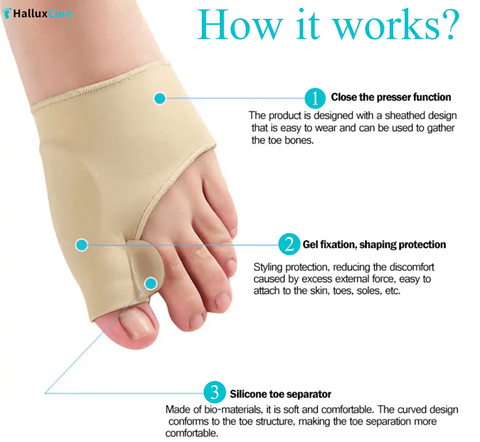To Fix or Not to Fix? Understanding Bunion Surgery and Alternative Solutions
Bunions are a common foot condition, particularly among women, that can range from mildly inconvenient to severely debilitating. For many, the decision to undergo bunion surgery isn’t straightforward, as evidenced by a Reddit commenter who shared her dilemma about living with a bunion on her left foot for years. She’s torn between opting for surgery now, as advised by her doctor, or continuing to manage the condition with the right footwear. If you're also debating whether to take the surgical route for bunion pain or explore non-invasive options, read on!
In this article, we’ll delve into everything you need to know about bunions, surgery, and effective alternatives, including the highly-rated Orthopedic Bunion Pain Relief & Correction Sleeve 4.9 ⭐⭐⭐⭐⭐ ( 1843 reviews )
What Causes Bunions?
A bunion is a bony bump that forms at the base of your big toe, caused by the misalignment of the bones in your foot. Over time, this misalignment can worsen, leading to pain, swelling, and difficulty finding comfortable footwear.
Common Triggers Include:
- Genetics: If your parents or grandparents had bunions, you might be predisposed.
- Improper Footwear: High heels or tight shoes can exacerbate the problem.
- Arthritis: Inflammatory conditions like rheumatoid arthritis can contribute.
- Foot Structure: Imbalances in how you walk or stand may lead to bunions.
The Pros and Cons of Bunion Surgery
Bunion surgery, or bunionectomy, is a procedure to realign the bones in your foot and remove the painful bump. While it can offer long-term relief, it's not without its challenges.
Benefits:
- Permanent correction of the bunion deformity.
- Reduction or elimination of pain and swelling.
- Improved mobility and ability to wear regular shoes.
Downsides:
- Recovery time can be lengthy, often taking 6–12 weeks.
- Post-surgery complications like stiffness or infection.
- Moderate to severe bunions may require hardware like screws or plates.
Before committing to surgery, it’s essential to evaluate your current pain levels and quality of life. In the Reddit comment mentioned earlier, the user asked if the surgery was worth it after a ladder accident exacerbated the condition. While trauma can accelerate the need for surgery, if you’re managing well with conservative measures, it might not be urgent.
Non-Surgical Alternatives: Managing Bunion Pain
If surgery feels like a big leap, you’ll be happy to know there are effective non-invasive options to manage bunion discomfort and prevent progression.
Top Conservative Approaches:
-
Proper Footwear
- Opt for wide-toe box shoes that don’t squeeze your toes.
- Avoid high heels or pointy-toe shoes altogether.
-
Orthopedic Supports
- Tools like bunion sleeves can provide immediate relief by realigning the toe and reducing pressure on the joint.
- For example, the Orthopedic Bunion Pain Relief & Correction Sleeve has received stellar reviews for its ability to alleviate discomfort while offering corrective support.
-
Physical Therapy
- Stretching exercises can improve flexibility and strengthen the muscles around the bunion.
- Toe spacers and resistance band exercises are particularly effective.
-
Pain Management
- Over-the-counter anti-inflammatories like ibuprofen can reduce swelling.
- Ice packs applied for 15–20 minutes can soothe sore spots.
Real Stories: To Operate or Not?
The Redditor’s question about whether surgery is worth it brings up an important point: every bunion journey is unique. Some people can manage bunion pain for decades with the right tools, while others find surgery transformative. The key lies in assessing your daily pain levels, activity restrictions, and long-term foot health goals.
If you’re not ready for surgery, incorporating bunion-friendly tools like the Tailor's Bunion Bunionette Pain Relief Protection Sleeves can be a game-changer.
Why Prevention and Maintenance Matter
Even if your bunion isn’t causing major problems now, it’s wise to take preventive measures to slow its progression. Early intervention can save you from more drastic procedures down the road.
Prevention Tips:
- Wear supportive shoes with arch support and cushioning.
- Use bunion cushions or splints to reduce pressure.
- Maintain a healthy weight to minimize stress on your feet.
- Avoid prolonged standing or high-impact activities without proper footwear.
Conclusion: What’s Your Next Step?
Deciding whether to have bunion surgery is deeply personal and depends on factors like pain tolerance, lifestyle, and long-term goals. For those who want to avoid surgery, non-invasive solutions like orthopedic sleeves and lifestyle adjustments can help manage the condition effectively.
Ready to Find Relief?
If you're looking for relief from bunion pain, consider using the Orthopedic Bunion Pain Relief & Correction Sleeve , which provides support and helps to alleviate discomfort.
For additional protection, the Tailor's Bunion Bunionette Pain Relief Protection Sleeves are designed to offer comfort and protection for bunionette pain.
To nourish and soothe the skin around bunions, as well as to promote healthy hair, consider the Jamaica Black Castor Oil Soothing Oil . Known for its moisturizing and anti-inflammatory properties, it helps alleviate discomfort around bunions and supports hair growth and scalp health.
What Do You Think?
Would you opt for bunion surgery, or do you prefer to stick with conservative measures? Share your story in the comments below—we’d love to hear your thoughts and experiences!



